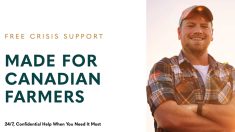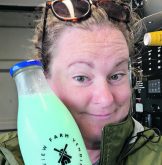On the Farm The Rosses, who have raised cattle in the Peace for 36 years, got into Red Angus before they were popular
CLEARDALE, Alta. — Lloyd and Donna Ross head to one of their pastures to check on the cattle. The animals are doing well, though Lloyd can always spot something that’s not up to his standards, even if it’s only a minor flaw.
He points to a cow that has a slightly uneven udder, but it’s 10 years old and has been producing offspring yearly.
“That’s a good cow,” he said. “But to be honest, there is no perfect cow.”
The Rosses have been running their purebred business, Clear River Red Angus, near Cleardale for 36 years.
Read Also

Nutritious pork packed with vitamins, essential minerals
Recipes for pork
But they are beginning to wind down. They plan on selling off their entire seedstock in November and then their bulls in spring.
While Lloyd is looking forward to retirement, he still has concerns about it.
“I wonder what I’m going to think about when we no longer have cattle,” he said. “When you run a business, you’re pretty focused.”
But he said the work has become a bit much. If his son, MacKay, wasn’t around to help, he said he would probably need to hire additional labour.
Donna has also retired from teaching full-time, and they are both ready to see more of the world.
“We travelled around Canada with the family when we were younger, but I’ve always wanted to see other places,” she said.

Donna and Lloyd first met each other near Strasbourg, Sask., in the mid-1970s. She was neighbours with his cousins.
They later married when Donna was studying at the University of Alberta in Edmonton. At the time, Lloyd was working in the oil patch.
But Lloyd soon decided he wanted to farm. His parents farmed near Cleardale, so it became an obvious place to start the business. There was also a school Donna could teach at.
In 1982, he got into purebred Red Angus because the animals weren’t popular at the time and he wanted to do something different.
“They served us through the bad years in the ’80s, the good years in the ’90s and the crash in 2003 with BSE,” he said. “We have survived quite well.”
The Rosses host their own auctions on the farm every year, mainly selling to commercial cattle producers. They also direct market some of their beef.
“I sell to other Red Angus producers that are running cattle the way they should be run in a commercial setting,” Lloyd said. “I want to see their cows working in a real environment.”
When breeding, he looks for females that are wedge-shaped, or narrow in the front and wider in the back, and they must become pregnant as yearlings. When the animals are two years or older, they must produce a live calf every year.
He likes to use his bulls for as long as possible. When he’s trying out a new bull, he puts it with cows that are having a calf for the second time or ones that are older. He never breeds a bull with its daughters and if it produces a smaller-than-normal calf, he’ll get rid of it.
“It would be nice to try out bulls before you buy them, but that’s not the way it works,” he said with a laugh.
His son, MacKay, who farms organic crops and does custom grazing, was initially going to take over the business, but later decided it wasn’t for him.
MacKay said he doesn’t have much patience with some buyers and that the profit margins just aren’t high enough for him.
“There were several reasons, and those two are very significant,” he said.
Lloyd supports MacKay’s decision. He has always told his children to follow their passion and put family first.
“I’ve always stressed to MacKay that he was never married to the farm business. He’s married to his wife, Jeanne, and his own family with their son, Alex.”
Lloyd also has two daughters, Amanda and Jeanie. Amanda teaches in Fairview, Alta., and Jeanie recently finished a master’s degree.
As they prepare for retirement, the Rosses don’t plan to sell their land, but they might consider renting some of it to neighbours.
“We’re not high rollers, but we live comfortably,” Lloyd said. “We’re not moving to Arizona or anything like that, although we might visit warmer climates for a couple of weeks a year.”


















